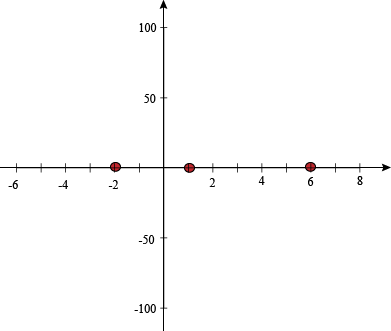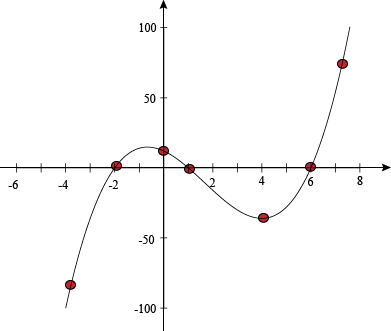First we need to find the factors for this polynomial. Using the Remainder Theorem, we'll focus on the factors of the constant 12: ±12, ±6, ±4, ±3, ±2, and ±1. At Shmoop, we follow the KISS principle whenever possible: Keep It Simple, Shmooper. Nothing is simpler than plugging in a 1. P(1) = (1)3 – 5(1)2 – 8(1) + 12 = 1 – 5 – 8 + 12 = 0 Another success for KISS: x – 1 is one of the factors. We're so happy, we could KISS you. Now we'll use this 1 in our synthetic division to find the other factors. 
The whole polynomial factors to: P(x) = (x – 1)(x2 – 4x – 12) = (x – 1)(x – 6)(x + 2) Solve for the roots: x – 1 = 0, x – 6 = 0, or x + 2 = 0 Our roots are x = 1, 6, and -2. Plot those zeros on the graph, so we can see what sections we need to investigate further. 
This polynomial is covered in third-degree burns, which is ironic because it has a degree of 3. As we take it to the hospital for treatment, we notice that its end behavior has one end pointing up and the other down. Now we're going to find one ordered pair in each section of the graph to find the general shape. These aren't the only numbers that will work, so feel free to find your own. You won't hurt our feelings. P(-3) = (-3)3 – 5(-3)2 – 8(-3) + 12 = -36 → (-3, -36) P(0) = (0)3 – 5(0)2 – 8(0) + 12 = 12 → (0, 12) P(3) = (3)3 – 5(3)2 – 8(3) + 12 = -30 → (3, -30) P(7) = (7)3 – 5(7)2 – 8(7) + 12 = 54 → (7, 54) Plot! Visualize! Enhance! 
|